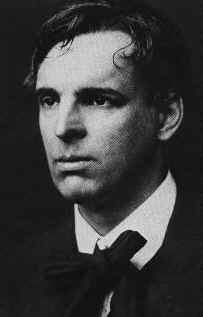 William Butler Yeats, (June 13, 1865 d. June 28,
1939) is known today as one of the greatest poets of the English language from the 20th
century. He was born in Dublin and raised as an Anglo-Irish
Protestant. Yeats's father attended Trinity College providing young
William with an intellectual heritage. This aristocratic position, combined
with his mother's emotional heritage, which encompassed rural culture in the
trade of ship-builders, gave Yeats a different perspective from many of his
contemporaries.
William Butler Yeats, (June 13, 1865 d. June 28,
1939) is known today as one of the greatest poets of the English language from the 20th
century. He was born in Dublin and raised as an Anglo-Irish
Protestant. Yeats's father attended Trinity College providing young
William with an intellectual heritage. This aristocratic position, combined
with his mother's emotional heritage, which encompassed rural culture in the
trade of ship-builders, gave Yeats a different perspective from many of his
contemporaries.
He
attended Dublin Art School. He began to write poetry at the age of
18. His interests in Irish legends and occults flooded his poetry and he
often alluded to many old Irish myths. As he grew older, his
obsession with his age and death became apparent in his poetry:
"The land of the Feary
where nobody gets old and godly and grave
where nobody gets old and crafty and wise
where nobody gets old and bitter of tongue."
Yeats also became increasingly attached to the country of Sligo. Interest in the
occult led him to the Dublin Hermetic Society and to join (in 1887) the London
Lodge of Theosophists. Yeats's encounter with John O'Leary caused him to
envision Ireland as the primary literary subject of his poetry, as well as the commitment
to the cause of Irish national identity, as expressed in "Easter
1916." In 1889, he fell in love with Maud Gonne and
alluded to his love in the 1899 poem, "The Wind among the Reeds,"
through symbolic, stylized, and expressive verse. In 1986, he befriended
Lady Isabella Augusta Gregory. She resided in Coole Park and Yeats's
frequent visits to this mystical place gave rise to new topics and a model of
"social grace." In 1900, he became the head of the Order of the
Golden Dawn in London, and in 1902, he was appointed President of the Irish
National Theatre Society later known as the Abbey Theatre.
Yeats devoted great
attention to the rebellion of 1916, as well as the independence of Ireland from
England granted in 1922, and evolved as key themes throughout his poetry,
characterizing the Middle Yeats period.
information
found from site: (http//:members.aol.com/KatharenaE/private/Pweek/Yeats/yeats.html)
 William Butler Yeats, (June 13, 1865 d. June 28,
1939) is known today as one of the greatest poets of the English language from the 20th
century. He was born in Dublin and raised as an Anglo-Irish
Protestant. Yeats's father attended Trinity College providing young
William with an intellectual heritage. This aristocratic position, combined
with his mother's emotional heritage, which encompassed rural culture in the
trade of ship-builders, gave Yeats a different perspective from many of his
contemporaries.
William Butler Yeats, (June 13, 1865 d. June 28,
1939) is known today as one of the greatest poets of the English language from the 20th
century. He was born in Dublin and raised as an Anglo-Irish
Protestant. Yeats's father attended Trinity College providing young
William with an intellectual heritage. This aristocratic position, combined
with his mother's emotional heritage, which encompassed rural culture in the
trade of ship-builders, gave Yeats a different perspective from many of his
contemporaries.